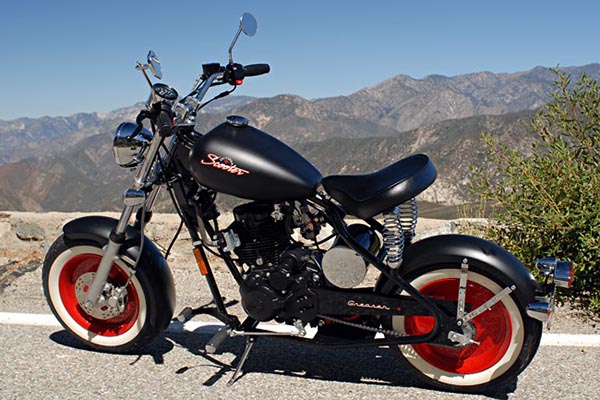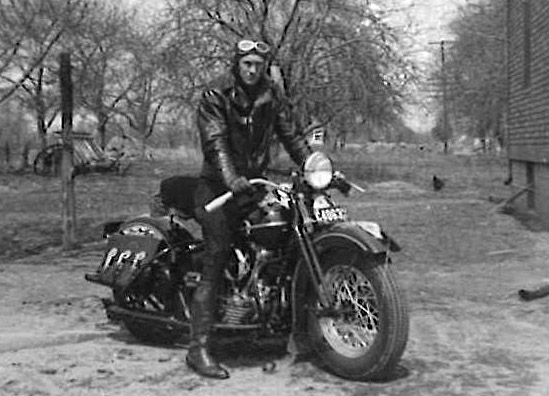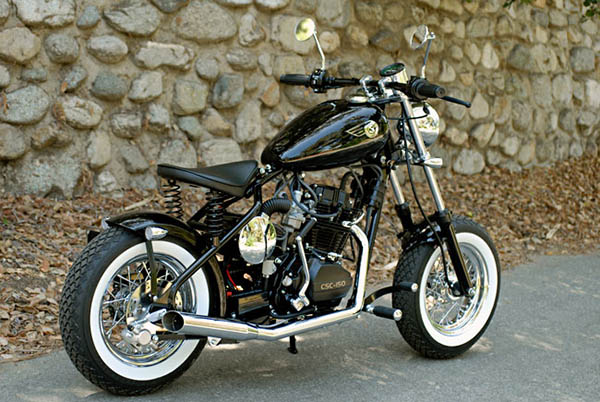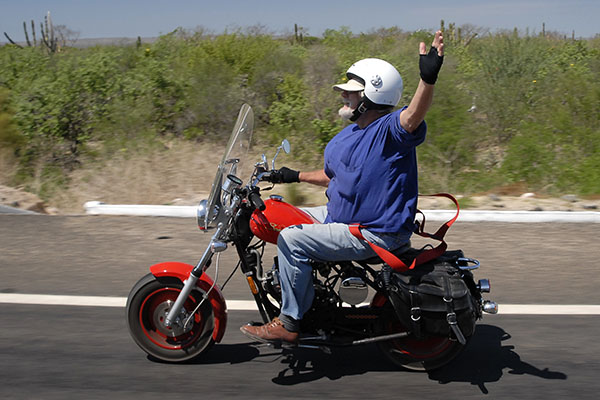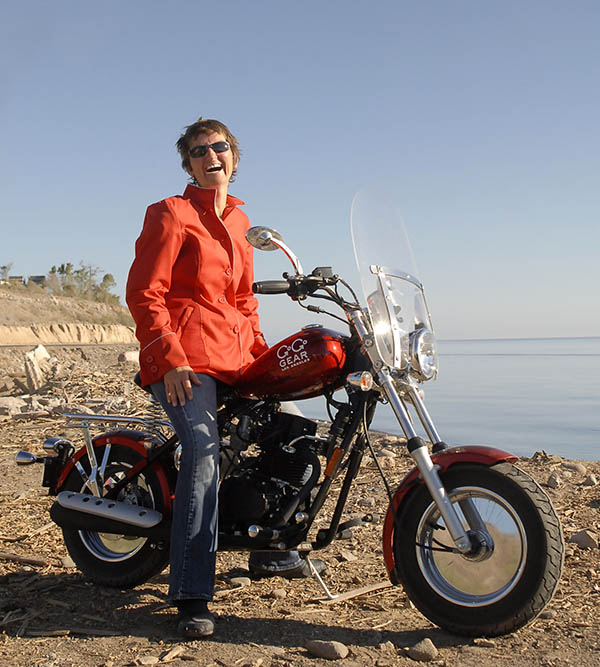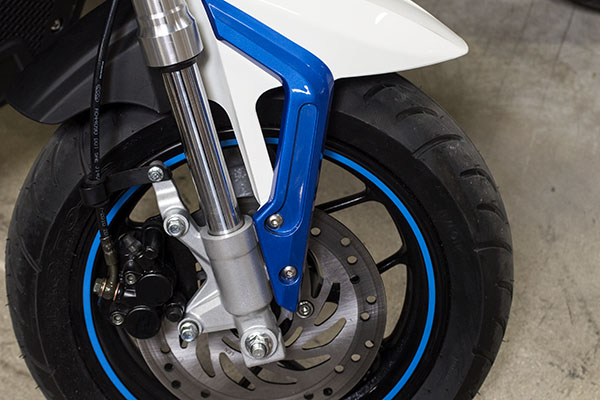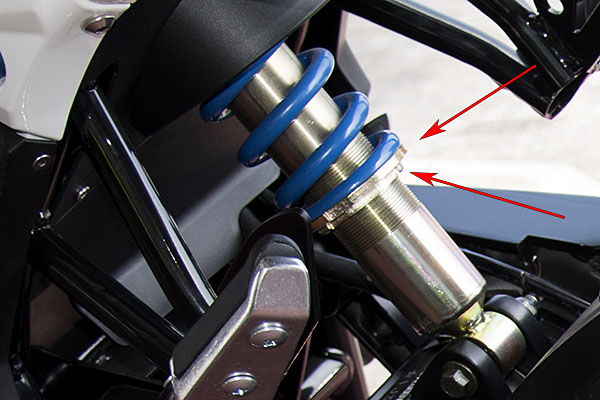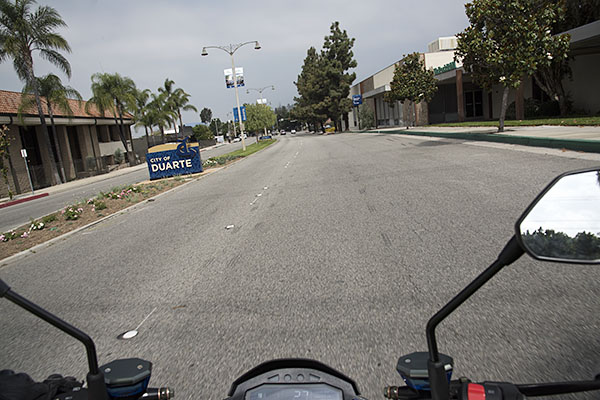To pick up where we left off, we’ll roll as far south as breakfast in Colonet in this blog. This was to be our first full day on the road, headed south to Cabo San Lucas!
We trucked the bikes down to San Ysidro just north of the border, hopped on the little Mustangs and we were off, with J following us in the chase truck. We had a spare bike in the back of the truck, and that’s when the fun began. We went through the border and took off; J was stopped immediately. Damn, we’re in the Tijuana traffic crucible, we lost J, and we didn’t have any telephone communications. But we did have a plan. Our rendezvous point in case we became separated was the Rosarito Beach Hotel, about 35 miles south of the border.
J was basically kicked out of Mexico as soon as he crossed the border because he didn’t have ownership documents and I guess the Mexican border agents didn’t want him bringing a motorcycle in the back of his truck into Mexico. It just never dawned on me that this would be a problem. Well, maybe it had…he had a letter from CSC authorizing use of the bike, but that wouldn’t cut it with the Mexican immigration folks.
Once he was back on the US side, J was able to reach the CSC truck by phone before it got too far north of the border. J and the CSC guys moved the bike from J’s truck to the CSC truck, and J hotfooted it down to Rosarito Beach, where we had a great lunch.

We rode through Ensenada, and then continued south into the northern Baja wine country. It was grand. Here we were, trekking south, on 150cc hardtail bikes, living large. We stopped in Palomar to top off at a Pemex station, had a snack, and continued.
Yep, you read that right. The CSC Mustangs were all hardtails. The only suspension was in the seat springs. Old school. Cool. You’d think our butts and back would take a beating, but that wasn’t the case at all. Those seat springs did what they were supposed. Surprisingly, at the end of the day we’d be feeling it in our wrists. The handlebars weren’t rubber mounted on the Mustangs, and when the rear wheel hit a bump, the shock went directly to your hands. But I digress. Back to the main attraction…our trek south…
Our little 150cc California Scooters purred. The bikes liked to run right at 45 mph. They just felt relaxed at that speed, and it’s about the perfect speed for riding on Mexico’s Transpeninsular Highway. Here’s a bit more on the impressively-named Transpeninsular Highway. Once you’re south of Ensenada, it’s a two-lane country road (one lane each way) that runs north and south (with lots of zigging and zagging along the way) for a cool 1000 miles, all the way down to Cabo.

After the wine country, Mexico Highway 1 (that’s the Transpensular Highway’s numeric designation) winds through little farming towns. In these little agricultural towns, the road is 4 or 5 feet higher than everything else. When you get off the road, you go down a pretty steep hill to get to the same level as the stores and other businesses, and there’s about a 30-foot dirt area between the street and the town on both sides of the street. People use this dirt area as sort of a parking lot and a street, so there’s traffic on the main road and the dirt areas on either side of the paved road. Which way the traffic flows in these dirt lanes depends mostly on…well, I don’t know. If I ever break the code, I’ll let you know.
We called it a night in San Vincente, and we checked into an inexpensive hotel (they’re all inexpensive down there). San Vincente was a hopping place that Friday night, which was a bit surprising to me. What wasn’t surprising is that we were the only gringos in San Vincente. That notwithstanding, we felt completely safe. All the bad press in the LA Times in those days about Mexico being dangerous was bunk (“bunk” is a nice word for, well, you know). There was so much bunk in the world back then about Mexico being dangerous that I sometimes wonder where it all came from. Is there a high-volume-production bunk factory out there I haven’t heard about? The mainstream media, and the LA Times in particular, was hell bent on portraying Mexico as a war zone. It’s not.
The point I’m making is that the Bajaenos are friendly, warm, and grateful that we visited this wonderful place. They had a double whammy down there…the recession, and the news media sensationalism painting all of Mexico as a terrible place. Not that San Vincente is a tourist area (it is not), but my sense of things is that the people we hung out with in San Vincente were glad to see us.



Arlene and I wandered around a bit, checked out a couple of mercados (grocery stores), and we ended up at another little place that was cooking up a bunch of stuff. Folks were lined up and there were barstools at a makeshift counter. All of this was outdoors. Arlene and I had quesadillas (I had two, actually). The guy who took care of us had this cool meat cooker that looked a lot like the ones I’ve seen in Turkey. He was cool with it all and he seemed to be greatly amused that I was taking his photo.

While we were enjoying the festive atmosphere and dinner, two young kids came up to us as I was savoring a real quesadilla (Taco Bell has no idea how good these are). It was pretty obvious we were out-of-towners, and one of the boys slowly said to me in perfect, unaccented English “It is very good, isn’t it?” I told him it was and asked his name. “Vinny,” he said. I took a flyer and asked if the other boy was his cousin. “No, he is my brother,” he said. Ah, okay. Not his cousin Vinny. Too bad. It would have added to the story.
We were up with the sun and on the road early the next morning, and it was cold. I had checked out the bikes the night before and all were fine (oil, tire pressure, the standard big-road-trip-preflight-stuff for loose nuts and bolts, etc.). I was surprised at how cold it was, because September is the hottest month of the year in Baja. I guess nobody told the weather people, though. Then the fog rolled in. It was thick. Not so thick that we couldn’t ride in it, but thick enough to soak my jeans and my gloves. We saw a coffee shop in Colonet and stopped for a caffeine fix.

I’ve done this run on big bikes many times previously and before we left I had a bit of trepidation about doing it on a 150cc motorcycle, but my fears were groundless. The seating position on those little Mustangs was perfect for this kind of riding, and the ergos were about the same as a Harley Sportster. Simon was surprised…he told me he felt the bike was extremely comfortable, and that it felt to him like a full-sized motorcycle (which is kind of what I was thinking). And this was coming from a guy who rode a 125 cc pizza delivery bike to the southernmost tip of South America and back, and then rode another bike across the length of India.
After that great cup of Colonet coffee, our 150cc trek south resumed…
To be continued…


